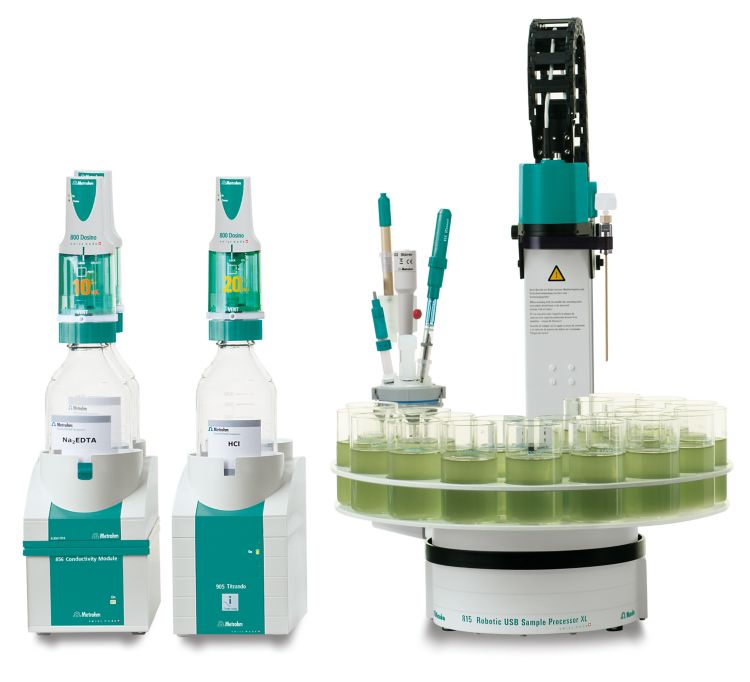The analysis of tap water plays an important role to assess the water quality or to identify possible contaminants. Parameters such as conductivity, pH value, alkalinity, water hardness, and chloride content are routinely analyzed.
In this application note, a fully automated system is presented which allows the determination of several parameters according to various standards within one analysis. These include conductivity (ISO 7888, EN 27888, ASTM D1125, EPA 120.1), pH value (EN ISO 10523, ASTM D1293, EPA 150.1), alkalinity (EN ISO 9963, ASTM D1067, EPA 310.1), Ca/Mg (ISO 6059, ASTM D1126, EPA 130.2), and chloride (ISO 9297, ASTM D512, EPA 325.3). Additionally the system transfers the required volume of sample into external titration vessels for the different analyses, reducing manual sample preparation. Furthermore, all sensors can be automatically calibrated and the titer of each titrant can also be determined.
This high degree of automation minimizes errors and guarantees outstanding reproducibility by freeing up valuable time for operators.
The method is demonstrated for a tap water sample. No sample preparation is required as the system automatically transfers the defined sample volume to external titration vessels after conductivity measurement.

This analysis is carried out automatically on an 815 Robotic USB Sample Processor XL equipped with two external titration vessels. One is set up with an iAquatrode plus and a combined Ca-ISE, and the second vessel is set up with an iAg-Titrode.
The samples are poured into beakers and then placed onto the rack. First, the conductivity measurement is directly performed in the beaker with a 5-ring conductivity measuring cell with integrated temperature sensor. Afterwards, a sample aliquot is transferred into the first external titration vessel to perform the pH measurement and then the alkalinity titration (using standardized HCl solution). Next, the pH value is adjusted by the addition of TRIS buffer, and the sample is titrated with standardized EDTA titrant until after the second equivalence point is reached. A second portion of the sample is transferred into the second titration vessel for the chloride determination with standardized silver nitrate titrant (after an acidification step). Finally, cleaning of both titration vessels and sensors is carried out automatically.
The pH electrode and the conductivity measuring cell are calibrated prior to the analysis.
The system enables reproducible results for all analyzed parameters. The overall analysis time for one sample is less than 15 minutes. All results are summarized in Table 1 and exemplary titration curves are given in Figures 2, 3, and 4.
| Parameter | Mean | SD(rel) in % |
|---|---|---|
| Conductivity | 567.4 µS/cm | 0.84 |
| pH value | 7.83 | 0.32 |
| p-value | N/A | N/A |
| m-value | 5.44 mmol/L | 0.09 |
| Calcium | 84.57 mg/L | 0.50 |
| Magnesium |
19.66 mg/L | 1.74 |
| Total hardness | 2.92 mmol/L | 0.62 |
| Chloride | 10.87 mg/L | 1.51 |
The high degree of automation for water analysis allows an increase in sample throughput, minimizes errors, and guarantees outstanding reproducibility. As the presented system includes sample preparation, the sample only needs to be placed in a beaker onto the rack and the system runs all analyses (conductivity, pH value, alkalinity, water hardness, and chloride) autonomously in one run. The automatic and accurate addition of the solutions combined with the automated system frees up valuable time of the operator and therefore increases the productivity in the lab.
Internal reference: AW TI CH1-1215-082011
 Share via email
Share via email
 Download PDF
Download PDF